Theoretical and Experimental Analysis of Grinding Stability of Beam Workpiece
Abstract
1. Introduction
2. Modeling of the Dynamic Grinding Force
2.1. Dynamic Cutting Thickness of a Single Abrasive Grain
2.2. Grinding Force Caused by Dynamic Cutting Thickness
3. Dynamic Equivalent Model of Grinding Wheel and Workpiece System
3.1. Dynamic Characteristic Test of Grinding Wheel and Workpiece
3.2. Dynamic Model of the Grinding Wheel
3.3. Dynamic Model of the Workpiece
4. Analysis of Grinding Stability
4.1. Mechanism of the Grinding Chatter
4.2. Influence of the Dynamic Characteristics of the System on the Grinding Stability
5. Experimental Validation
5.1. Experimental Setup
5.2. Results of the Experiment
 represents the experiment groups in which chatter developed and
represents the experiment groups in which chatter developed and  represents the experiment groups without chatter. From Figure 17, only near the lobe curve was there a small error between the experimental and calculated results with the model. This error could be attributed to the simplifying assumptions of the model.
represents the experiment groups without chatter. From Figure 17, only near the lobe curve was there a small error between the experimental and calculated results with the model. This error could be attributed to the simplifying assumptions of the model.6. Conclusions
- (1)
- The stability limit curves at any position in the longitudinal direction could be acquired from the chatter model, which provided valuable information on chatter avoidance for the industry. With the same grinding parameters, the stability of the beam grinding system decreased with increasing distance from the fastener.
- (2)
- The stability of the system increased with the increased damping ratio of the grinding wheel and workpiece, and the influence of the workpiece damping ratio on the system stability was less than that of the grinding wheel damping ratio.
- (3)
- From the grinding experiments, chatter marks were observed on the surface after grinding in the chatter state. Compared to the stable vibration signal, the energy of the chatter signal was mainly concentrated at the chatter frequency, which was higher than the natural frequency of the grinding wheel.
Author Contributions
Funding
Institutional Review Board Statement
Informed Consent Statement
Data Availability Statement
Acknowledgments
Conflicts of Interest
References
- Zhao, D.; Liu, J.; Wu, C.Q. Stability and local bifurcation of parameter-excited vibration of pipes conveying pulsating fluid under thermal loading. Appl. Math. Mech. 2015, 36, 1017–1032. [Google Scholar] [CrossRef]
- Wang, W.K.; Wan, M.; Zhang, W.H.; Yang, Y. Chatter detection methods in the machining processes: A review. J. Manuf. Process. 2022, 77, 240–259. [Google Scholar] [CrossRef]
- Zhang, P.; Gao, D.; Lu, Y.; Kong, L.; Ma, Z. Online chatter detection in milling process based on fast iterative VMD and energy ratio difference. Measurement 2022, 194, 111060. [Google Scholar] [CrossRef]
- Hou, Y.; Yao, P.; Zhang, H.; Liu, X.; Liu, H.; Huang, C.; Zhang, Z. Chatter stability and surface quality in milling of unidirectional carbon fiber reinforced polymer. Compos. Struct. 2021, 271, 114131. [Google Scholar] [CrossRef]
- Altintas, Y.; Weck, M. Chatter Stability of Metal Cutting and Grinding. CIRP Ann. 2004, 53, 619–642. [Google Scholar] [CrossRef]
- Malkin, S.; Guo, C. Grinding Technology: Theory and Applications of Machining with Abrasives; Industrial Press: New York, NY, USA, 2008. [Google Scholar]
- Chen, Q.; Li, W.; Ren, Y.; Zhou, Z. 3D chatter stability of high-speed micromilling by considering nonlinear cutting coefficients, and process damping. J. Manuf. Process. 2020, 57, 552–565. [Google Scholar] [CrossRef]
- Sun, C.; Niu, Y.; Liu, Z.; Wang, Y.; Xiu, S. Study on the surface topography considering grinding chatter based on dynamics and reliability. Int. J. Adv. Manuf. Technol. 2017, 92, 3273–3286. [Google Scholar] [CrossRef]
- Sun, C.; Liu, Z.; Lan, D.; Duan, J.; Xiu, S. Study on the influence of the grinding chatter on the workpiece’s microstructure transformation. Int. J. Adv. Manuf. Tech. 2018, 96, 3861–3879. [Google Scholar] [CrossRef]
- Zhang, Y.; Fang, C.; Huang, G.; Xu, X. Modeling and simulation of the distribution of undeformed chip thicknesses in surface grinding. Int. J. Mach. Tools Manuf. 2018, 127, 14–27. [Google Scholar] [CrossRef]
- Ding, W.; Dai, C.; Yu, T.; Xu, J.; Fu, Y. Grinding performance of textured monolayer CBN wheels: Undeformed chip thickness nonuniformity modeling and ground surface topography prediction. Int. J. Mach. Tools. Manuf. 2017, 122, 66–80. [Google Scholar] [CrossRef]
- Zhang, W.; Zhang, P.; Zhang, J.; Fan, X.; Zhu, M. Probing the effect of abrasive grit size on rail grinding behaviors. J. Manuf. Process. 2020, 53, 388–395. [Google Scholar] [CrossRef]
- Inasaki, I.; Karpuschewski, B.; Lee, H.S. Grinding Chatter–Origin and Suppression. CIRP Ann. 2001, 50, 515–534. [Google Scholar] [CrossRef]
- Álvarez, J.; Barrenetxea, D.; Marquínez, J.; Bediaga, I.; Gallego, I. Effectiveness of continuous workpiece speed variation (CWSV) for chatter avoidance in throughfeed centerless grinding. Int. J. Mach. Tools Manuf. 2011, 51, 911–917. [Google Scholar] [CrossRef]
- Barrenetxea, D.; Marquinez, J.I.; Bediaga, I.; Uriarte, L. Continuous workpiece speed variation (CWSV): Model based practical application to avoid chatter in grinding. CIRP Ann. 2009, 58, 319–322. [Google Scholar] [CrossRef]
- Hahn, R.S. On the theory of regenerative chatter in precision-grinding operations. Trans. Am. Soc. Mech. Eng. 1954, 76, 593–597. [Google Scholar] [CrossRef]
- Snoeys, R.; Brown, D. Dominating parameters in grinding wheel—And workpiece regenerative chatter. Adv. Mach. Tool Des. Res. 1970, 325–348. [Google Scholar]
- Thompson, R.A. On the doubly regenerative stability of a grinder. J. Eng. Ind. 1974, 96, 275–280. [Google Scholar] [CrossRef]
- Thompson, R.A. On the doubly regenerative stability of a grinder: The combined effect of wheel and workpiece speed. J. Eng. Ind. 1977, 99, 237–241. [Google Scholar] [CrossRef]
- Thompson, R.A. On the doubly regenerative stability of a grinder: The mathematica analysis of chatter growth. J. Eng. Ind. 1986, 108, 83–92. [Google Scholar] [CrossRef]
- Thompson, R.A. On the doubly regenerative stability of a grinder: The effect of contact stiffness and wave filtering. J. Eng. Ind. 1992, 114, 53–60. [Google Scholar] [CrossRef]
- Li, H.; Shin, Y.C. Wheel regenerative chatter of surface grinding. J. Manuf. Sci. Eng. 2005, 128, 393–403. [Google Scholar] [CrossRef]
- Li, H.; Shin, Y.C. A time-domain dynamic model for chatter prediction of cylindrical plunge grinding processes. J. Manuf. Sci. Eng. 2006, 128, 404–415. [Google Scholar] [CrossRef]
- Li, H.; Shin, Y.C. A study on chatter boundaries of cylindrical plunge grinding with process condition-dependent dynamics. Int. J. Mach. Tools Manuf. 2007, 47, 1563–1572. [Google Scholar] [CrossRef]
- Chung, K.W.; Liu, Z. Nonlinear analysis of chatter vibration in a cylindrical transverse grinding process with two time delays usinganonlinear time transformation method. Nonlinear Dyn. 2011, 66, 441–456. [Google Scholar] [CrossRef]
- Yan, Y.; Xu, J.; Wiercigroch, M. Regenerative chatter in self-interrupted plunge grinding. Meccanica 2016, 51, 3185–3202. [Google Scholar] [CrossRef]
- Yan, Y.; Xu, J.; Wiercigroch, M. Regenerative and frictional chatter in plunge grinding. Nonlinear Dyn. 2016, 86, 283–307. [Google Scholar] [CrossRef]
- Yan, Y.; Xu, J.; Wiercigroch, M. Regenerative chatter in a plunge grinding process with workpiece imbalance. Int. J. Adv. Manuf. Technol. 2017, 89, 2845–2862. [Google Scholar] [CrossRef]
- Koro, K.; Abe, K.; Ishida, M.; Suzuki, T. Timoshenko beam finite element for vehicle—Track vibration analysis and its application to jointed railway track. J. Rail Rapid Transit 2004, 218, 159–172. [Google Scholar] [CrossRef]
- Timoshenko, S.P. On the correction for shear of the differential equation for transverse vibrations of prismatic bars. Philos. Mag. 1921, 41, 744–746. [Google Scholar] [CrossRef]
- Liu, Y.; Wang, X.; Lin, J.; Kong, X. An adaptive grinding chatter detection method considering the chatter frequency shift characteristic. Mech. Syst. Signal Process. 2020, 142, 106672. [Google Scholar] [CrossRef]
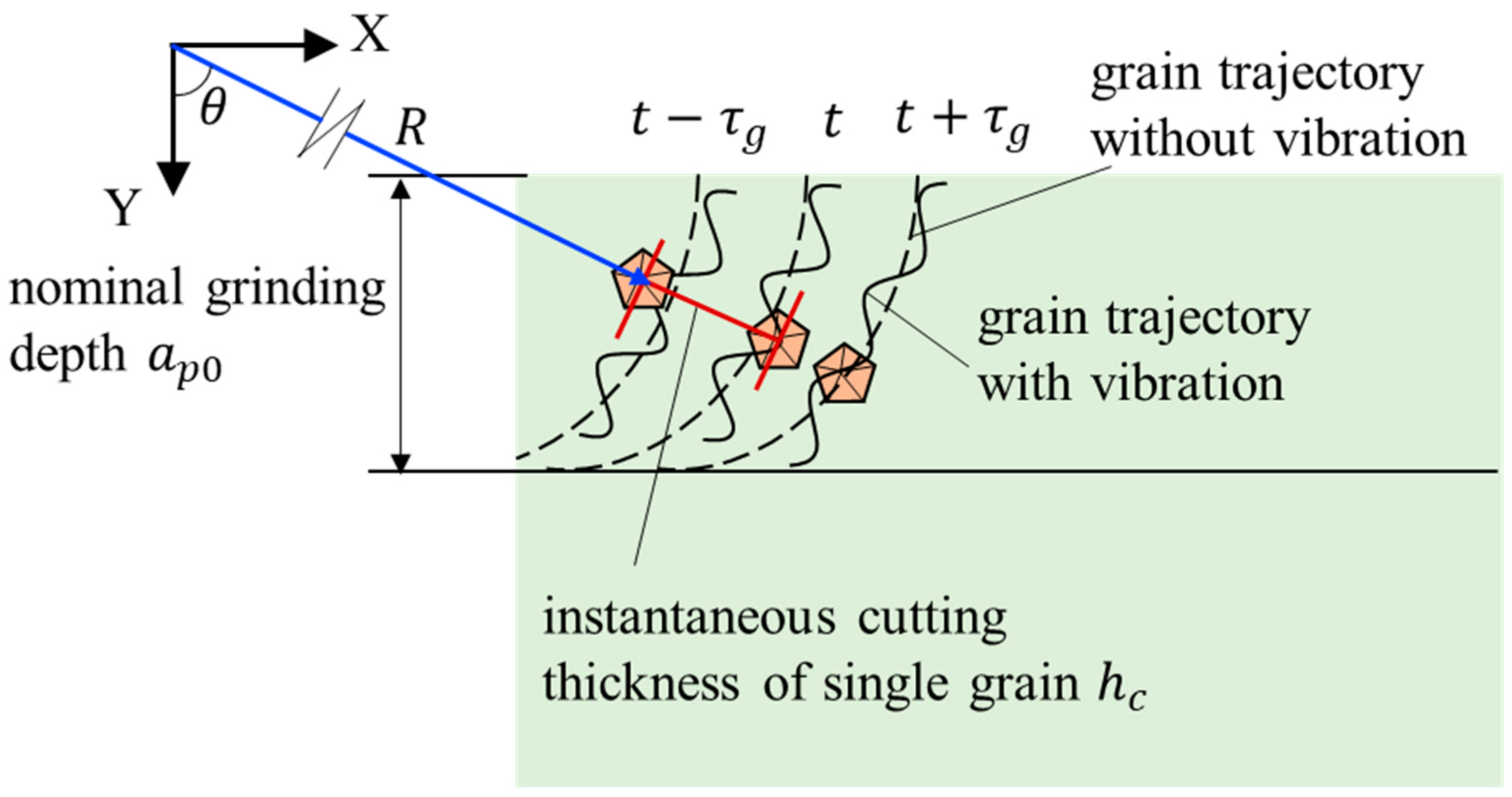
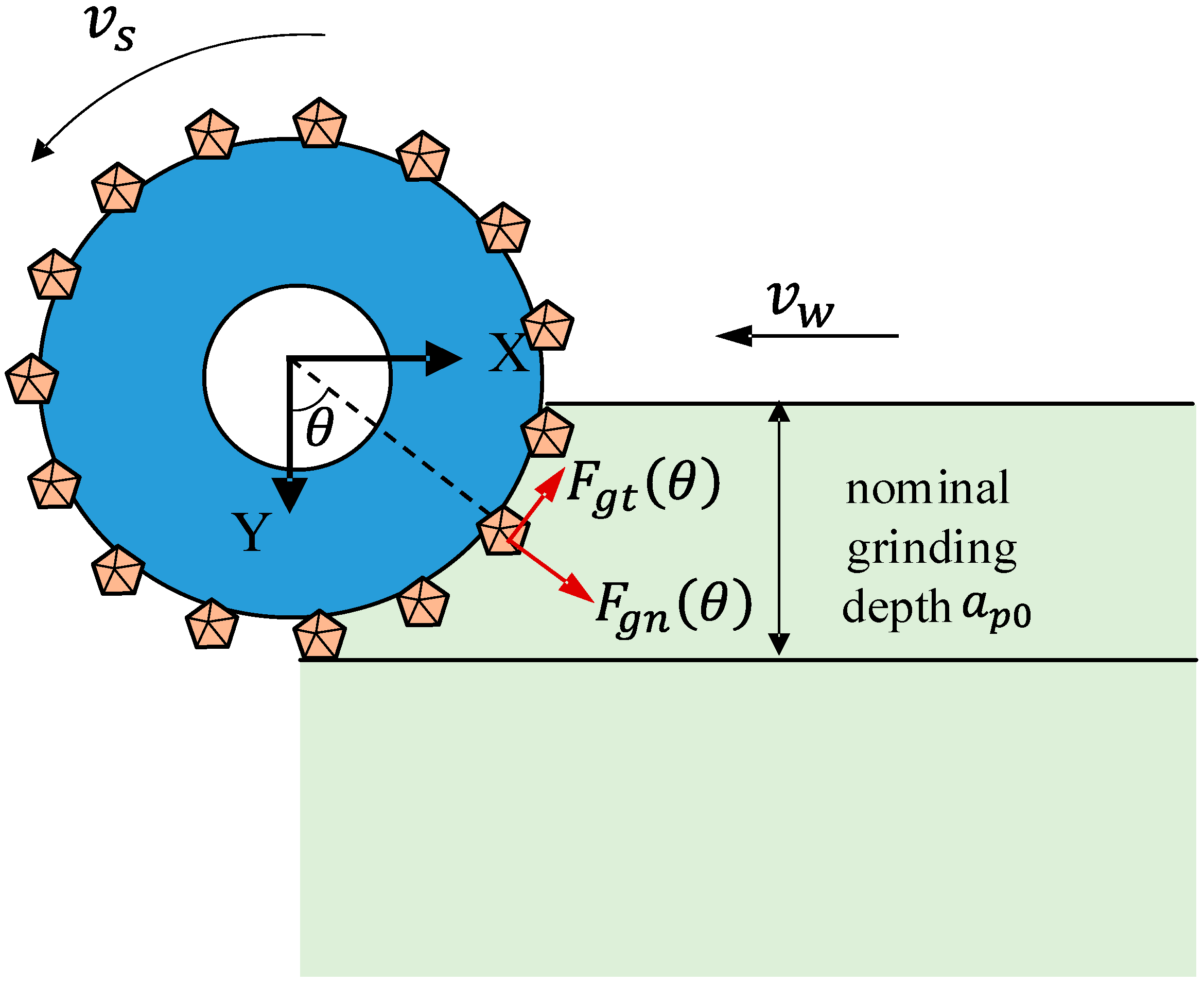

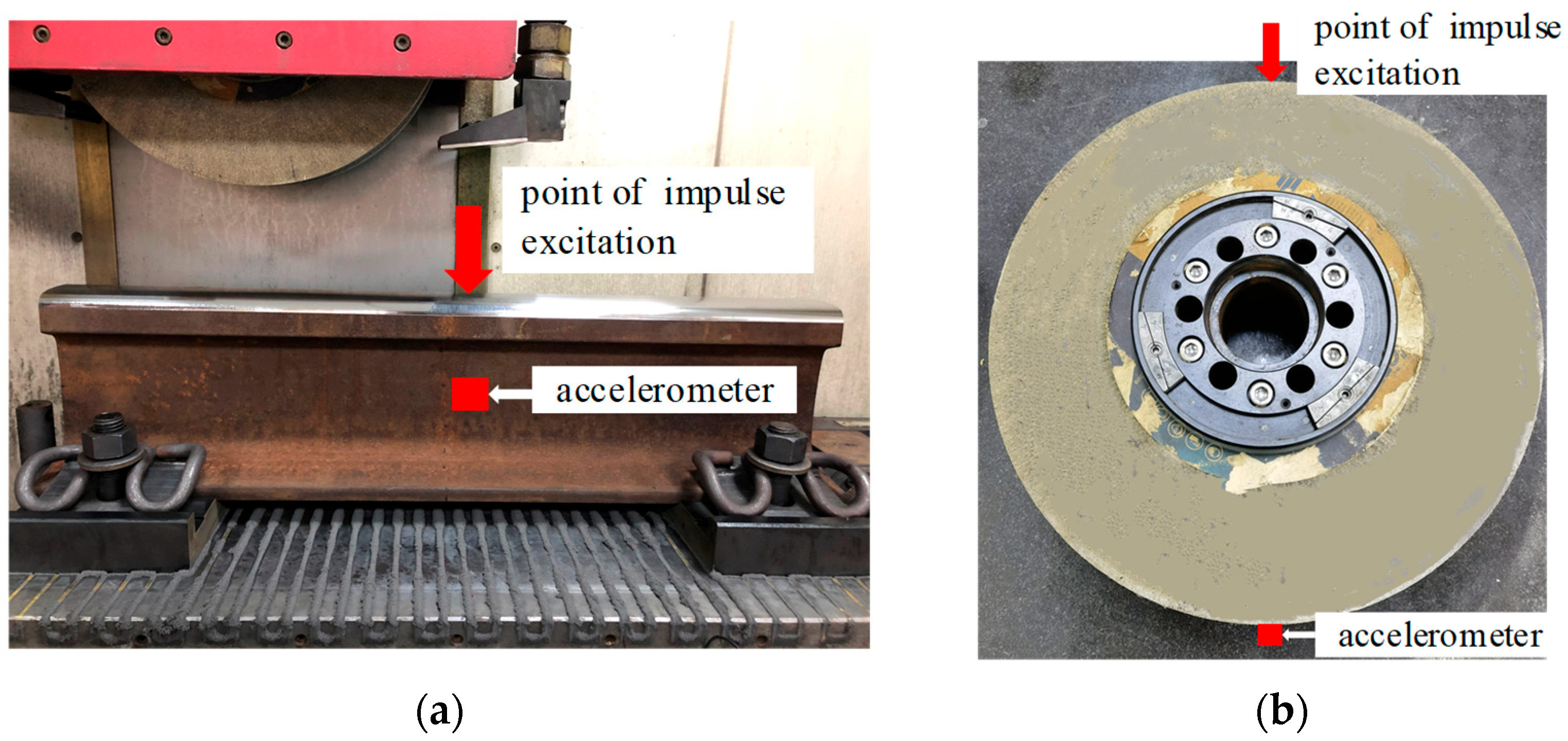
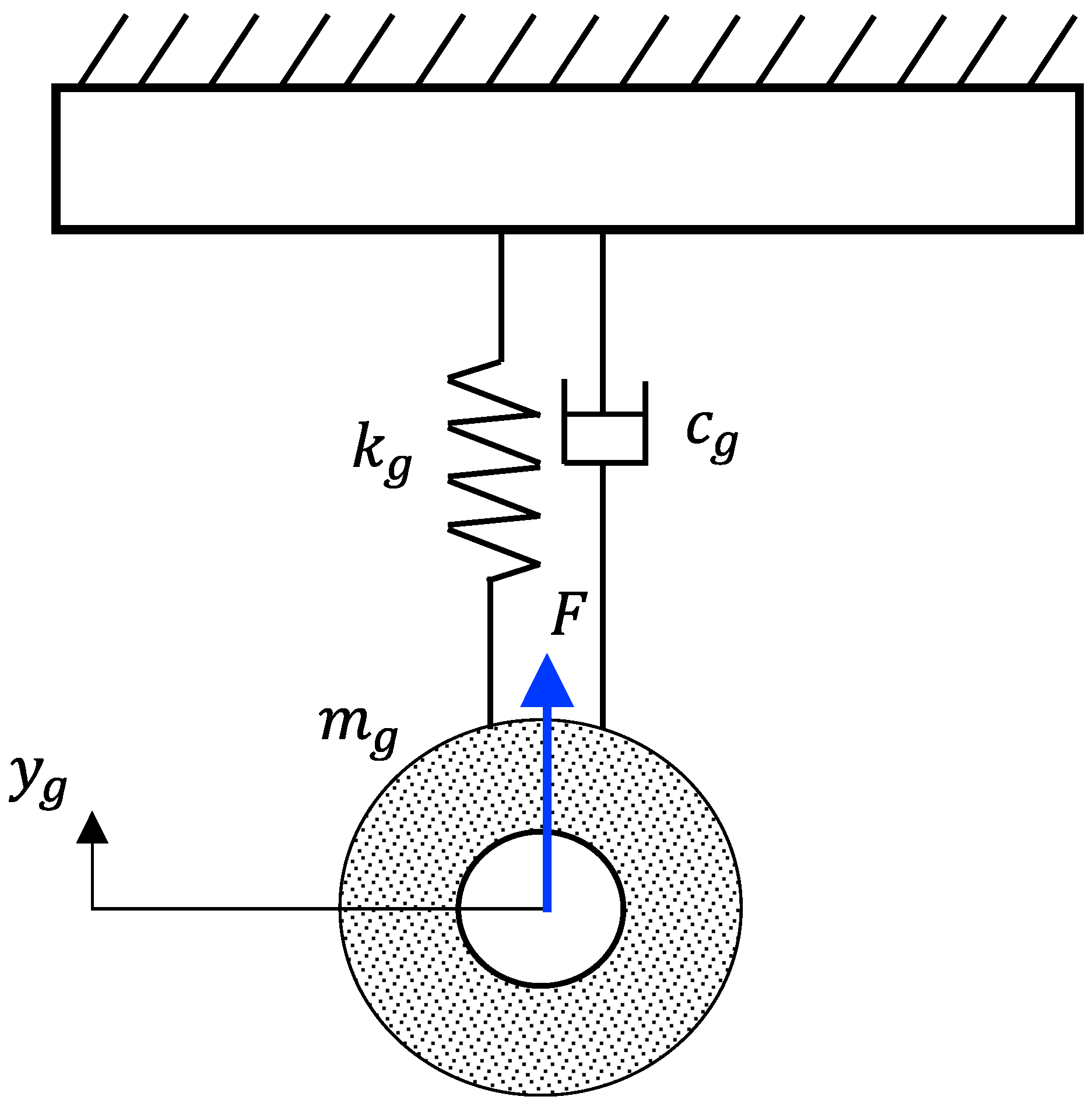
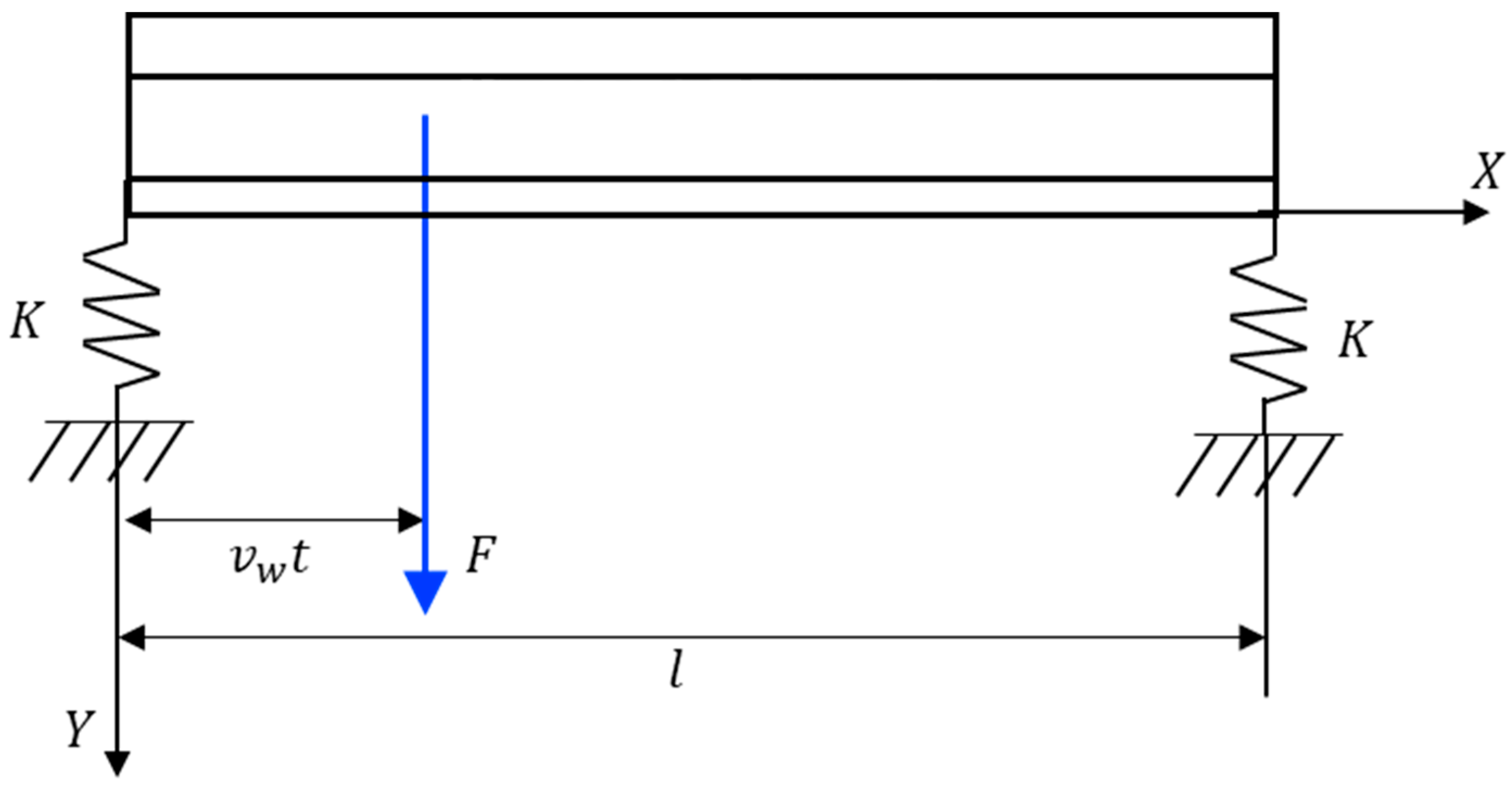
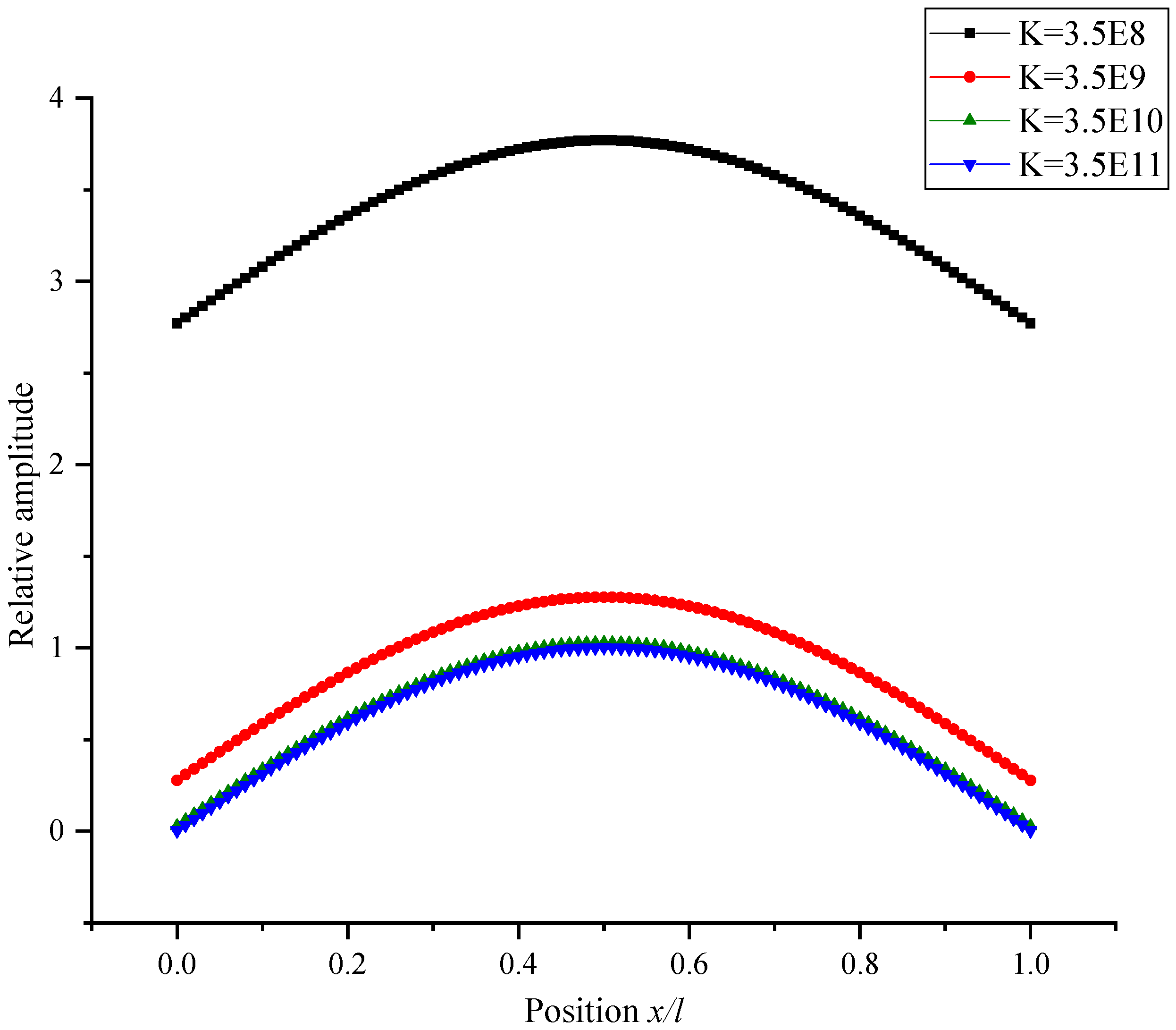
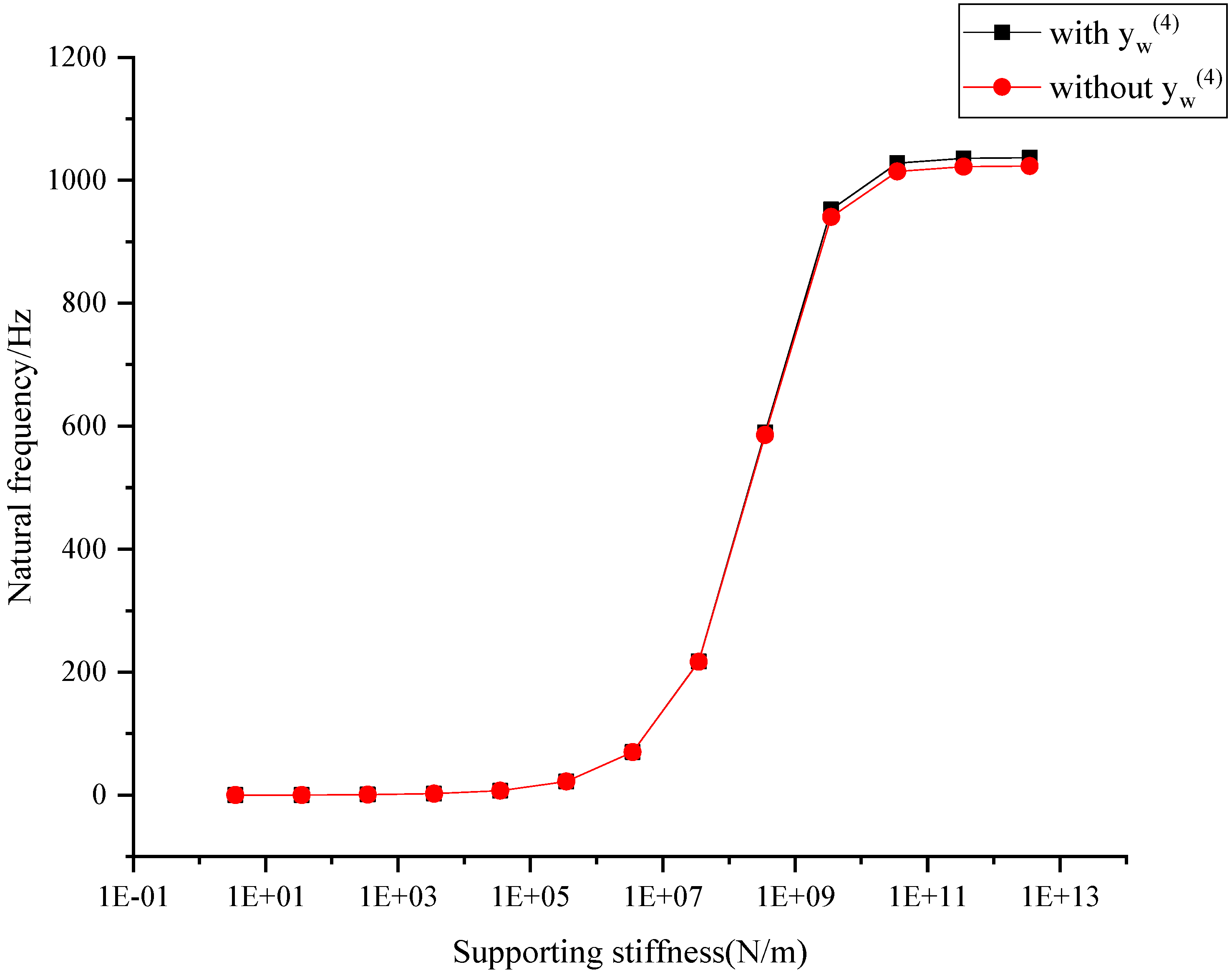
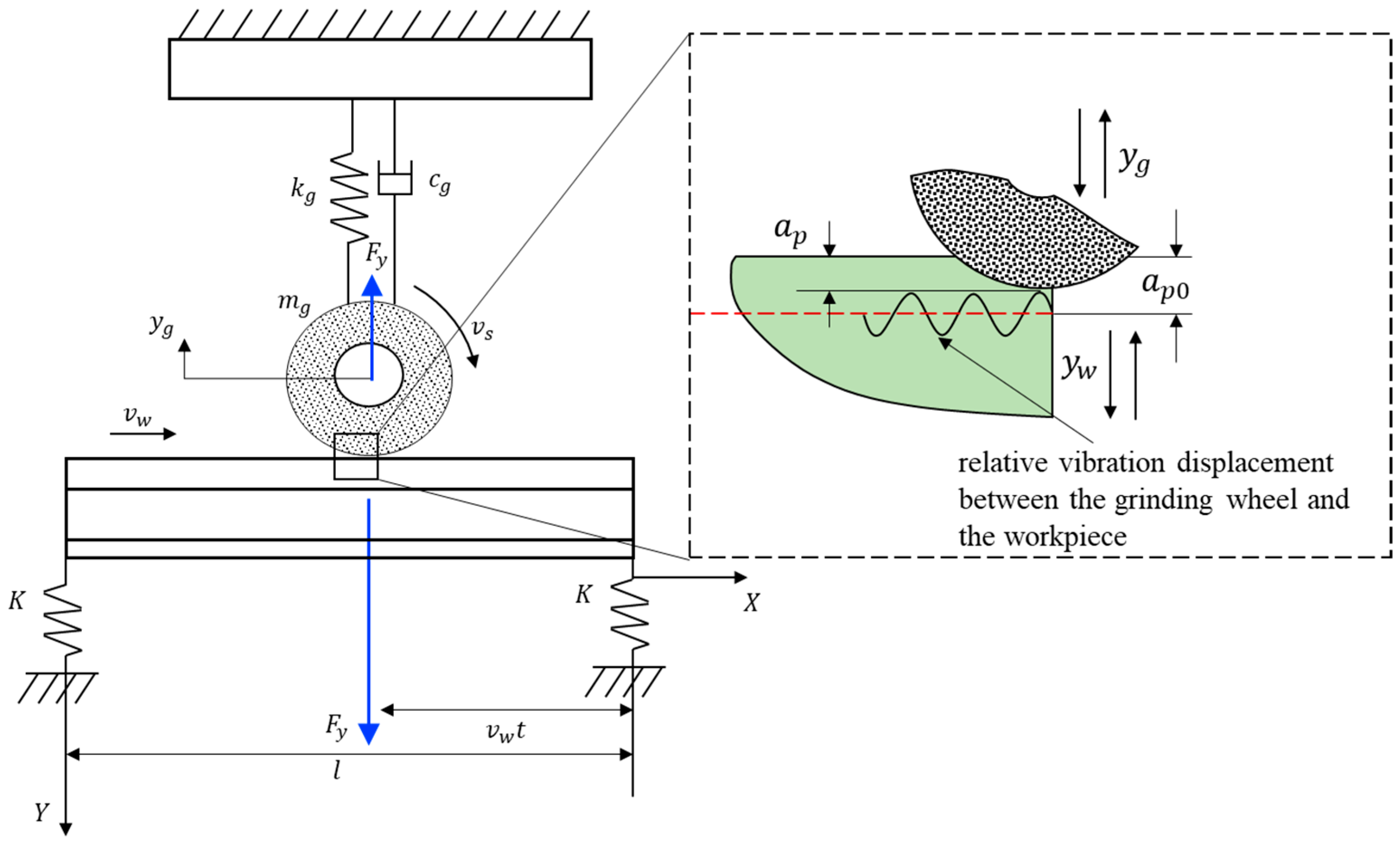
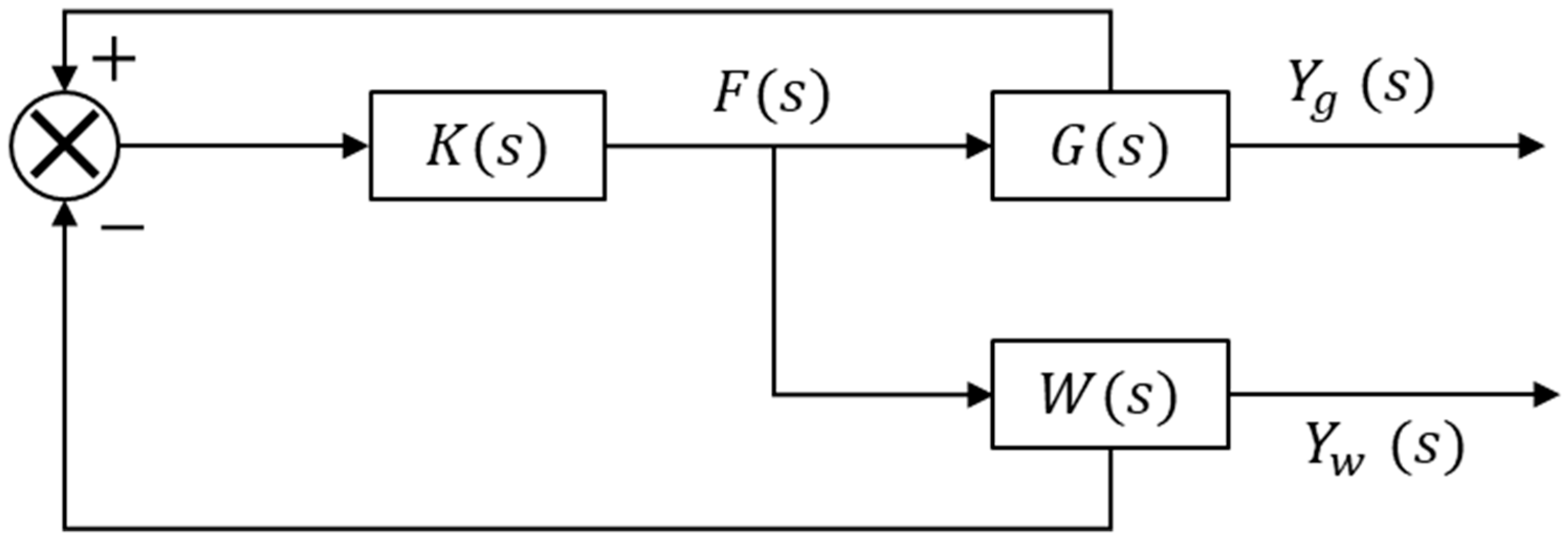
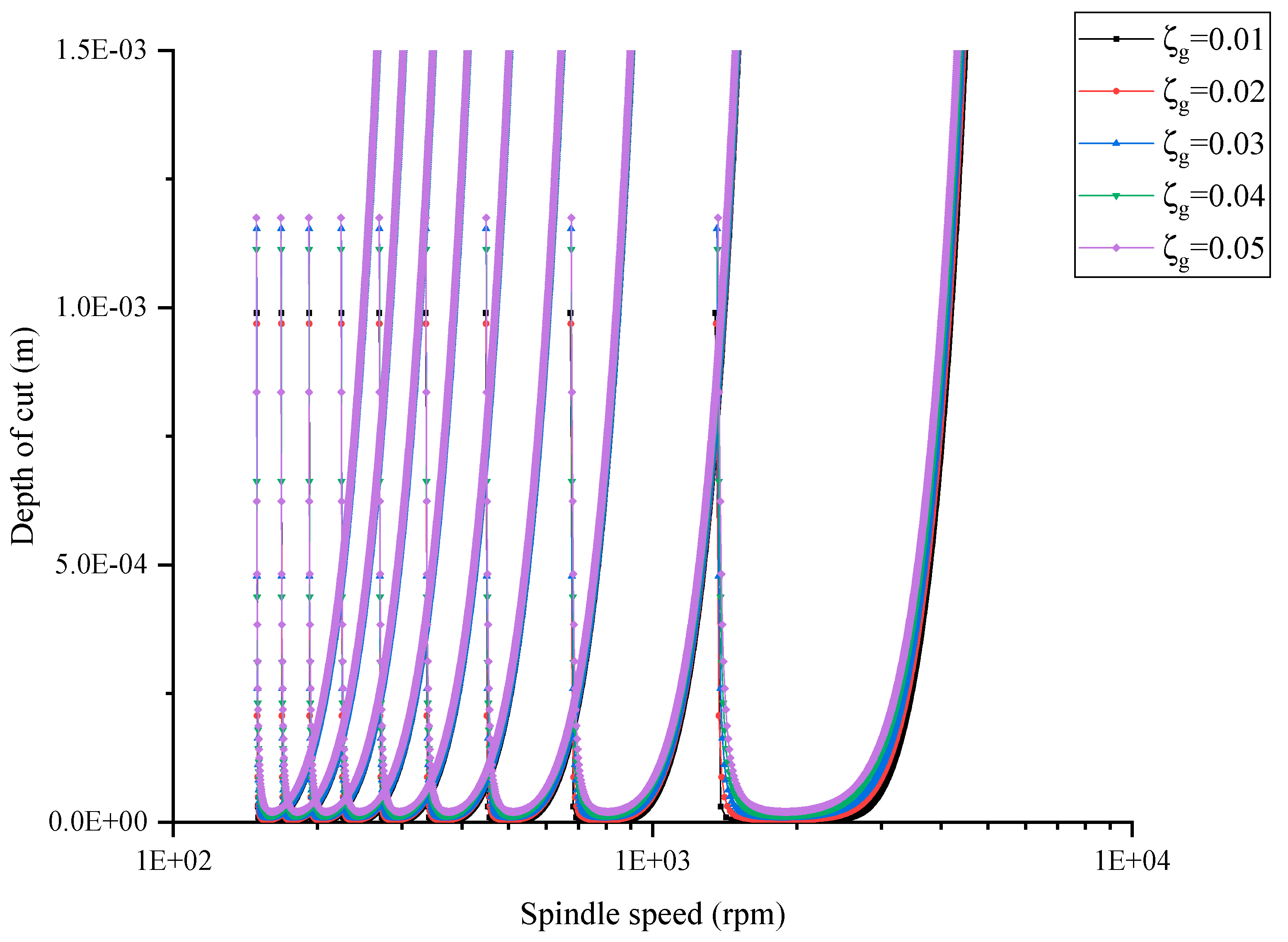
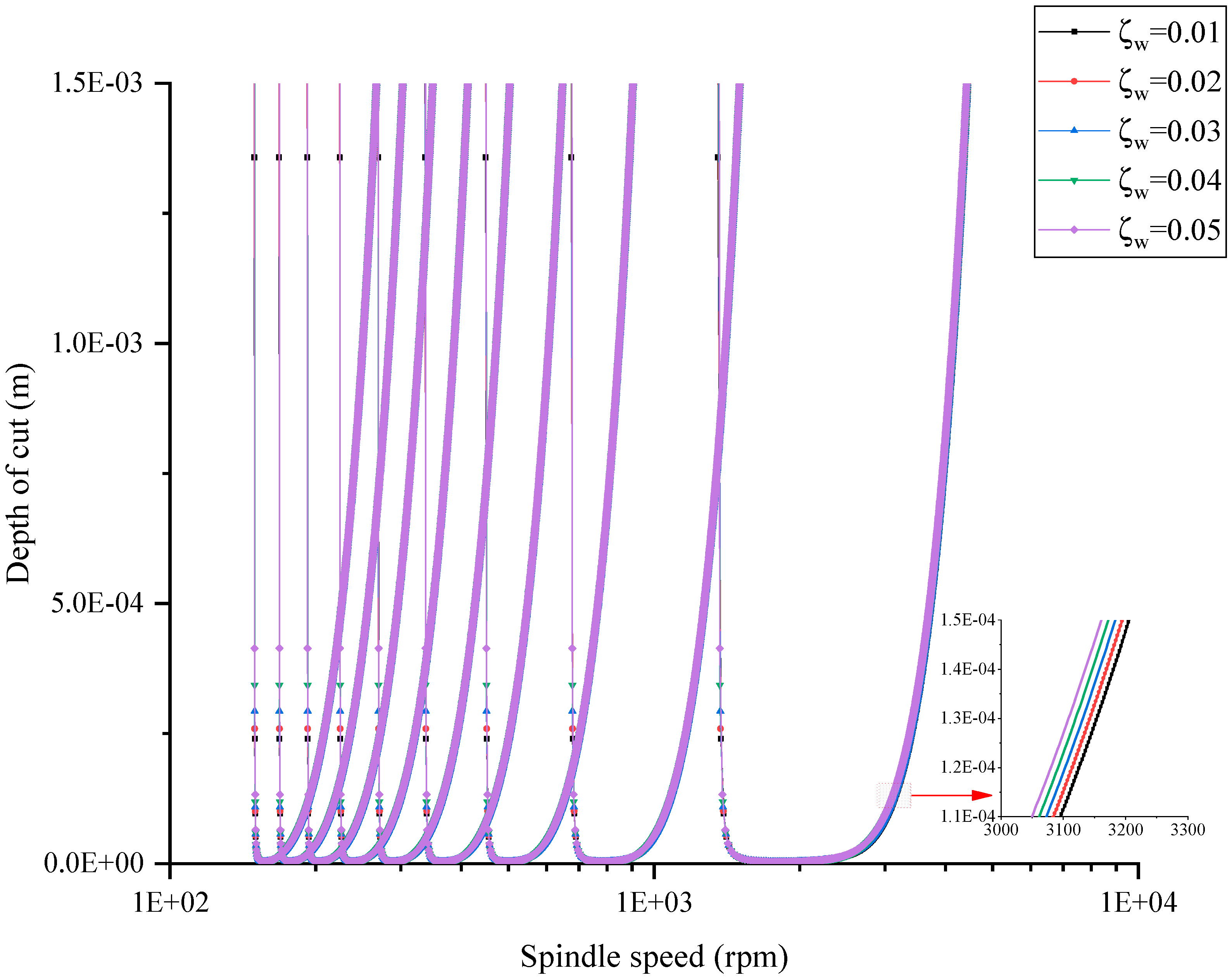
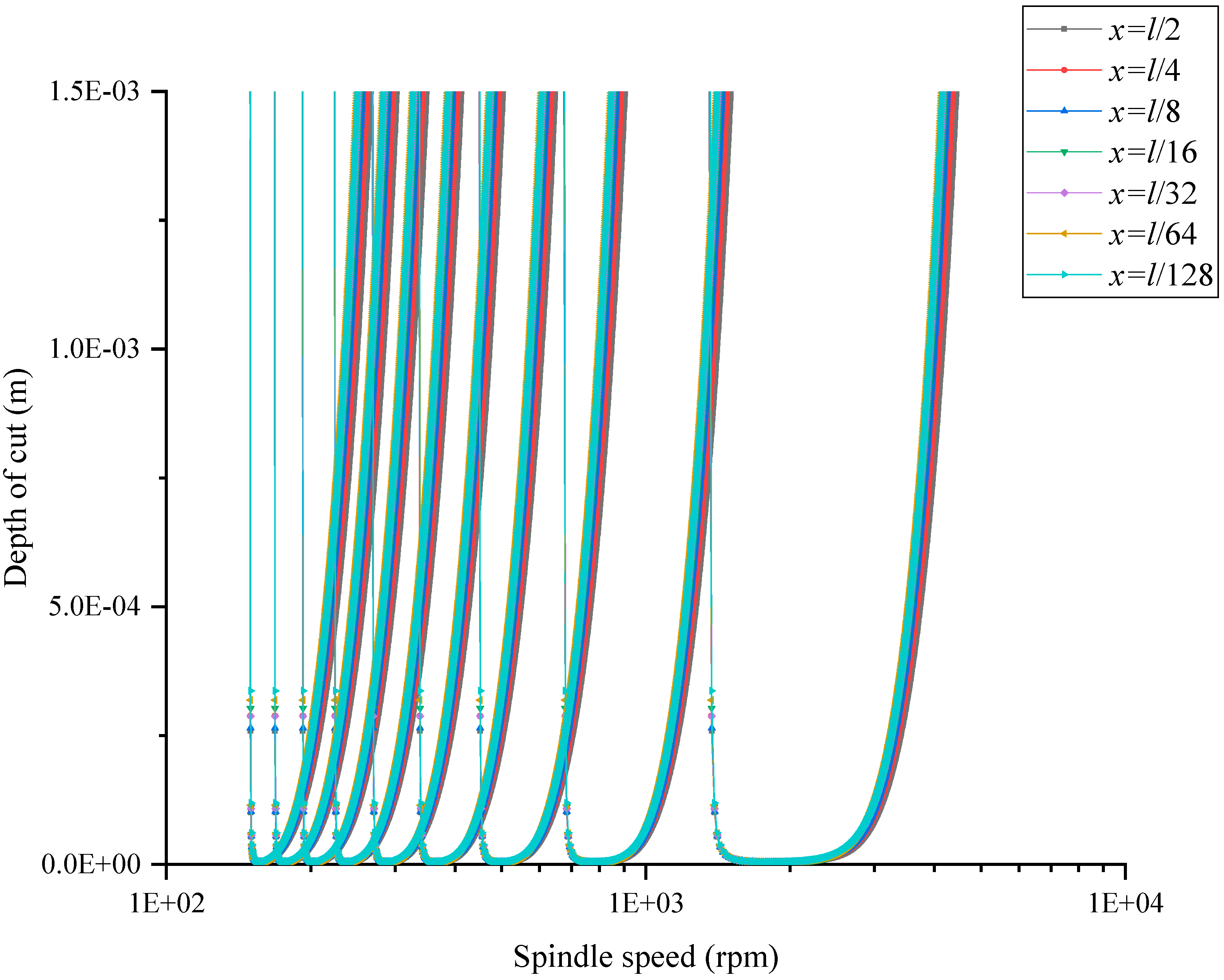

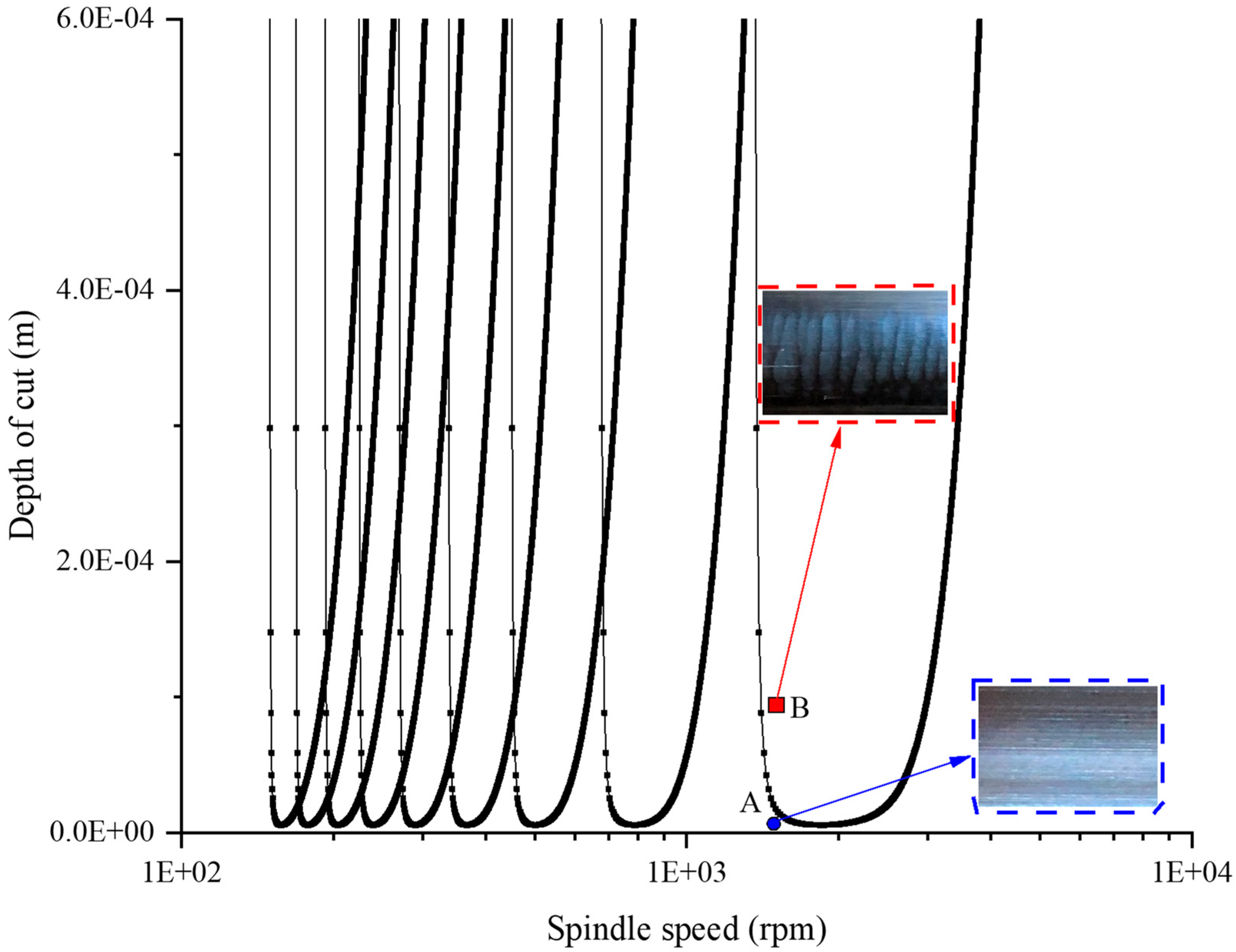


| Test Object | Dominant Natural Frequency/Hz | Damping Ratio/% |
|---|---|---|
| Grinding wheel | 1007.55 | 2.47 |
| Workpiece | 908.05 | 3.13 |
| Parameters | Value |
|---|---|
| 7850 kg/m3 | |
| m2 | |
| N/m2 | |
| m4 | |
| 0.34 | |
| N/m2 |
| ns (rpm) | ap (mm) |
|---|---|
| 1250, 1500, 2000, 3000, 3500 | 0.01, 0.05, 0.1, 0.2, 0.3 |
Disclaimer/Publisher’s Note: The statements, opinions and data contained in all publications are solely those of the individual author(s) and contributor(s) and not of MDPI and/or the editor(s). MDPI and/or the editor(s) disclaim responsibility for any injury to people or property resulting from any ideas, methods, instructions or products referred to in the content. |
© 2023 by the authors. Licensee MDPI, Basel, Switzerland. This article is an open access article distributed under the terms and conditions of the Creative Commons Attribution (CC BY) license (https://creativecommons.org/licenses/by/4.0/).
Share and Cite
Wu, H.; Yao, Z. Theoretical and Experimental Analysis of Grinding Stability of Beam Workpiece. Processes 2023, 11, 1702. https://doi.org/10.3390/pr11061702
Wu H, Yao Z. Theoretical and Experimental Analysis of Grinding Stability of Beam Workpiece. Processes. 2023; 11(6):1702. https://doi.org/10.3390/pr11061702
Chicago/Turabian StyleWu, Han, and Zhenqiang Yao. 2023. "Theoretical and Experimental Analysis of Grinding Stability of Beam Workpiece" Processes 11, no. 6: 1702. https://doi.org/10.3390/pr11061702
APA StyleWu, H., & Yao, Z. (2023). Theoretical and Experimental Analysis of Grinding Stability of Beam Workpiece. Processes, 11(6), 1702. https://doi.org/10.3390/pr11061702





